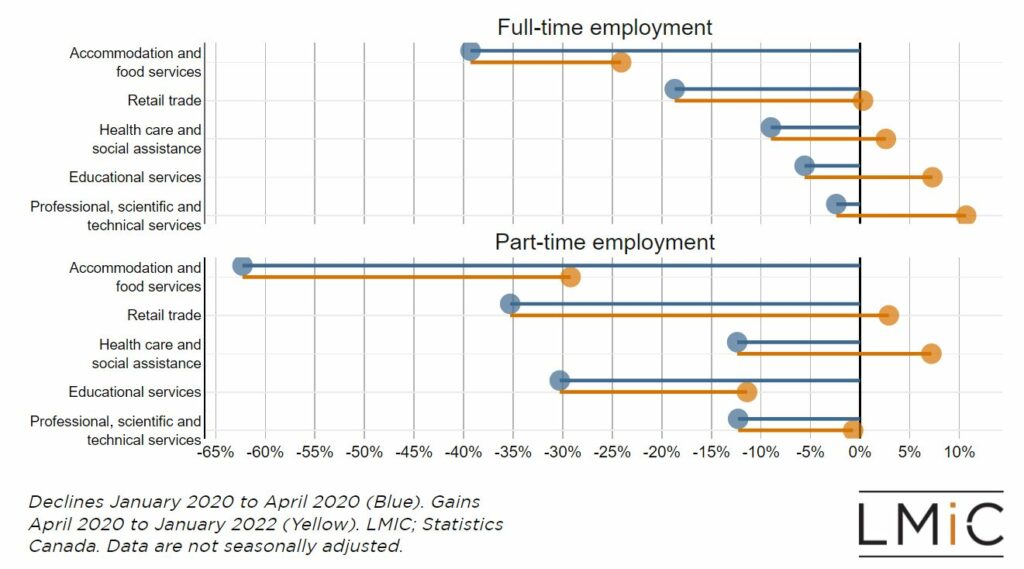
It’s International Women’s Day. What do we know about the state of women’s employment in Canada?
Listen to this article as an audio recording
Today is International Women’s Day, and we’re entering the third year of the COVID-19 pandemic. So today we’re asking ourselves: what do we know now, in March 2022, about the effects the previous two years have had on women’s employment in Canada?
We know that women have been significantly impacted by COVID-19, and media are reporting that the “she-cession” isn’t over yet. There have been articles about how women are increasingly pursuing new careers in the trades, as well as reports of inequities in recovery.
But what does the available data say about how women’s employment is faring?
LMIC economist Brittany Feor and senior economist Behnoush Amery dug into what the numbers can tell us.
Here’s what they learned.
Women’s recovery is strong in full-time employment, but part-time employment lags
Prior to the pandemic, women accounted for more than two-thirds (64%) of part-time employment (less than 30 hours per week) despite women making up 48% of all workers. When COVID-19 hit in the spring of 2020, the relative employment losses were much larger for women working part-time (-30%) than those working full-time (-12%).
Since April 2020, employment recovery has been strong for women in full-time employment, while part-time employment has not yet recovered to pre-pandemic levels.
Women in accommodation and food services have been hardest hit
In January 2020, about 60% of women in the labour force worked in five sectors:
- 22.3% worked in health care and social assistance
- 12.8% worked in retail trade
- 11.3% worked in educational services
- 7.5% worked in accommodation and food services
- 7.5% worked in professional, scientific and technical services
As Figure 1 shows, across these five sectors, employment losses were more pronounced for women working part-time than full-time between January and April 2020.
Employment losses were most severe for women working in the accommodation and food services sector (-350,000), dropping 62% for part-time employment and 39% for full-time employment.
The retail trade sector comes in second in terms of employment losses for women in the spring of 2020 – women lost about 35% of part-time jobs and 19% of full-time jobs in the retail trade sector.
Women in educational services also had a significant drop in part-time employment at 30%, compared to their full-time counterparts’ drop in part-time employment at 6%.
Figure 1: Employment climbs for women working full-time in key sectors but employment is still down for women working part-time and full-time in accommodation and food services

The employment recovery up to January 2022 (the latest data available at the time this blog article was published) shows that full-time employment has recovered to pre-pandemic levels in all sectors – except for accommodation and food services.
The accommodation and food services sector was particularly hard hit by the pandemic, as well as by business restrictions in early 2022 due to the Omicron variant in Quebec and Ontario. As of January 2022, employment in this sector remains down overall by more than 180,000 (-26.8%), with the net job loss spread across both full-time (-24%) and part-time (-29%) employment.
Meanwhile, the number of women working full-time in the other four sectors has increased over the past two years.
Full-time employment for women surpassed the pre-pandemic levels in professional, scientific and technical services by 11%, educational services by 7%, health care and social assistance by 3%, and retail trade by less than 1%.
In two of these four sectors the number of women in part-time employment has recovered to pre-pandemic levels (health care and social assistance up by 7%; retail trade up by 3%).
Part-time employment for women in professional, scientific and technical services, and educational services remains below pre-pandemic levels, down by 1% and 11% respectively.
The data can’t tell us why part-time employment isn’t recovering as quickly
It is difficult to pinpoint the reason why part-time employment for women is still lagging in recovery.
One possibility is that the slower increase in part-time employment might be due to a shift towards full-time and more stable employment for women.
Another possibility is that women who were not in the labour force before the pandemic have moved into full-time positions, and women working part-time prior to the pandemic have not returned to their part-time employment.
There are many reasons why some women have not returned to the labour force but without the available data it is not possible to understand the full reasoning.
What we’re doing to further explore women’s employment trends
Since the spring of 2020, women’s full-time employment recovery has been strong, whereas part-time employment recovery has lagged – both changes that are influenced by complex and intersecting sociodemographic factors.
In an upcoming report, we further explore the labour market outcomes of women in a recovering labour market. Stay tuned for this spring 2022 release!
Illustration by Dorothy Leung for LMIC.

